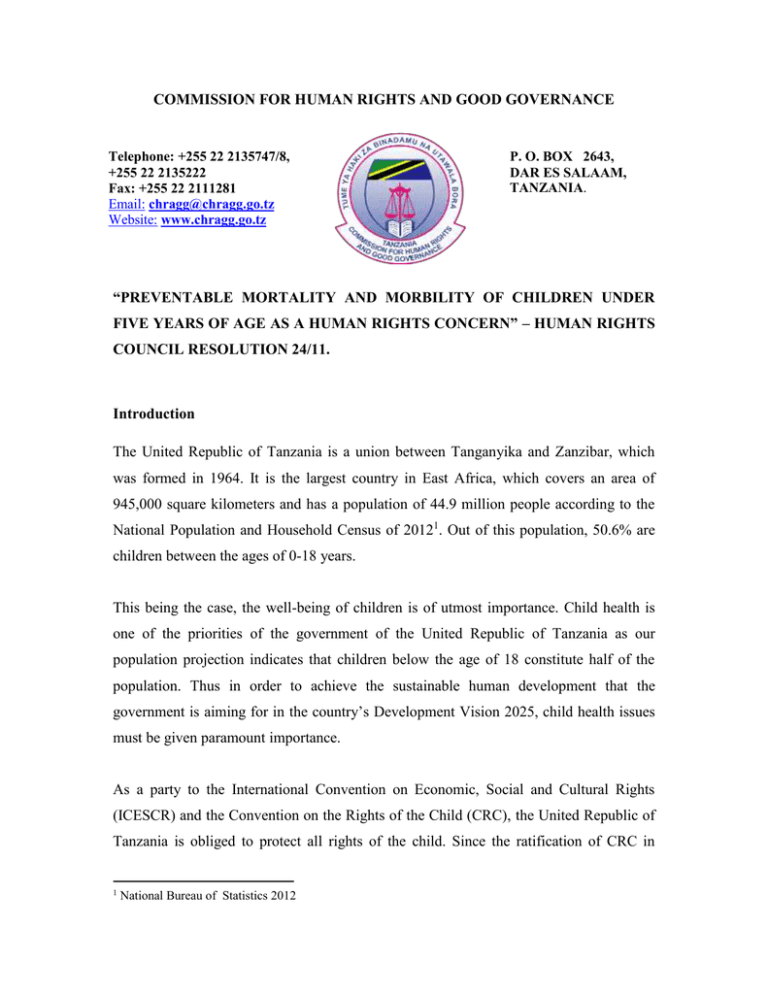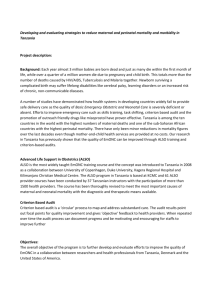COMMISSION FOR HUMAN RIGHTS AND GOOD GOVERNANCE
advertisement

COMMISSION FOR HUMAN RIGHTS AND GOOD GOVERNANCE Telephone: +255 22 2135747/8, +255 22 2135222 Fax: +255 22 2111281 Email: chragg@chragg.go.tz Website: www.chragg.go.tz P. O. BOX 2643, DAR ES SALAAM, TANZANIA. “PREVENTABLE MORTALITY AND MORBILITY OF CHILDREN UNDER FIVE YEARS OF AGE AS A HUMAN RIGHTS CONCERN” – HUMAN RIGHTS COUNCIL RESOLUTION 24/11. Introduction The United Republic of Tanzania is a union between Tanganyika and Zanzibar, which was formed in 1964. It is the largest country in East Africa, which covers an area of 945,000 square kilometers and has a population of 44.9 million people according to the National Population and Household Census of 20121. Out of this population, 50.6% are children between the ages of 0-18 years. This being the case, the well-being of children is of utmost importance. Child health is one of the priorities of the government of the United Republic of Tanzania as our population projection indicates that children below the age of 18 constitute half of the population. Thus in order to achieve the sustainable human development that the government is aiming for in the country’s Development Vision 2025, child health issues must be given paramount importance. As a party to the International Convention on Economic, Social and Cultural Rights (ICESCR) and the Convention on the Rights of the Child (CRC), the United Republic of Tanzania is obliged to protect all rights of the child. Since the ratification of CRC in 1 National Bureau of Statistics 2012 1991, Tanzania has taken several measures concerning the implementation of the CRC and specifically the right to health. The Health Situation in Tanzania The health sector in Tanzania has been identified as a priority area in several government strategies and policies such as the National Strategy for Growth and Poverty Reduction (NSGRP- MKUKUTA) in Mainland Tanzania and the Strategy for Growth and Reduction of Poverty (MKUZA) in Zanzibar. These policies provide the direction for achievement of the Millennium Development Goals (MDGs). The Health Policy of 2007 provides the government’s vision on long-term developments in the health sector and the National Road Map Strategic Plan to Accelerate the Reduction of Maternal and Newborn Mortality (2008-2015), among others. The Health Sector Reform Programme continues with efforts to strengthen the Local Government Authorities and hospitals in order to improve the provision of health services. Generally, the overall Government objective as far as health issues are concerned is to improve the health and well-being of all Tanzanians by urging all authorities dealing with health matters to improve the services in the health sector, and to be more responsive to the need of the people. Tanzanian like other developing countries faces the problem of low standards of living including poor housing and sanitation. The under five children in Tanzania face a high risk of death at an early age with more than 1 in 10 children dying before reaching their fifth birthday. The under five children mortality is caused by infections like pneumonia/ sepsis, diarrhea, malaria, tetanus, low birth weight, malnutrition, congenital, childhood ailments and HIV/AIDS. Neonatal mortality rate was reported to be 26 deaths per 1,000 in 2010 and the deaths are mainly caused by infections, asphyxia, low birth preterm, congenital and diarrhea and neonatal tetanus. Also there are some other factors which indirectly contribute to child mortality in Tanzania namely low level of education and poverty at family, early pregnancies and marriage, lack of child care services, shortage of health staff, lack of medical facilities, shortage of and distant health facilities, traditions and customs. Over the past five years, positive trends on different health indicators have been seen with a decreasing of infant and under five mortality rates. Notable progress in the improvement of child health as child mortality rate reduced from I37 deaths per 1000 live births to 81 deaths per 1000 live births for children under five years and from 88 to 51 deaths per 1000 live births for infants2. The National Road Map Strategic Plan (2008 – 2015) has contributed in these remarkable changes. Other positive developments have been seen on the countrywide coverage of child immunization of childhood/infant diseases and vitamin A supplementation. The Government provides free prenatal and childbirth services. Apart from little success obtained in the health sector, there are still a number of issues that challenge and hinder quality provision of services. Among them are inadequate human resources to deliver quality health services, poor transport and infrastructure to health facilities, poor and inadequate medical supplies due to budgetary constraints. ACTIVITIES DONE BY CHRAGG TO REDUCE MORTALITY AND MORBIDITY OF UNDER FIVE CHILDREN IN TANZANIA The establishment of the Commission for Human Rights and Good Governance (CHRAGG) is among of state effort to preserve, protect and observe human rights in the country as per international, regional and national standards. CHRAGG is an independent government department, established as the national focal point for the promotion and protection of human rights and duties as well as good governance principles in Tanzania. The reduction of child mortality rate and improvement of the rights of newborn and child health should adhere to human rights based approach as emphasized3 that “When a 2 3 NBS (2010)Tanzania Demographic Health Survey Report Statement by Hon. Getrude Mongela the former president of the Pan African Parliament. woman undertakes her biological role of becoming pregnant and undergoing childbirth, the society has an obligation to fulfill her basic human rights and that of her child”. (i) Advocating and monitoring of health rights for children CHRAGG as National Human Rights Institution (NHRI) has played a role in overseeing state efforts in realizing the health right. Since its establishment, the Commission embarked in various campaigns for child health through various activities. The campaign focuses on the importance of immunization, the need for adequate provision of nutritional services, discouraging belief in witchcraft and encouraging parents to take sick children to health facilities rather than to witch doctors, registration of newborn and the health rights of children who are in detention facilities with their mothers. (ii) Meeting with the Local Government Authorities The Commission has been meeting with the Local Government Authorities (LGAs) to discuss issues affecting child health in the country. CHRAGG has been working to ensure accountability, participation, transparency and non discrimination in service delivery at local government levels while urging the Central Government to ensure availability of adequate drugs and medical equipment to ensure delivery of quality health services in hospitals, dispensaries and other health centers. CHRAGG has also been raising awareness and sensitizing people on their duty to participate individually and collectively in planning and implementation of their health care programs through the LGAs. The Commission also monitors the implementation of health policy related to availability of free of charge medical services to children under five. (iii) Health rights of children detained with their mothers The commission4 also is mandated to visit prisons and other places of detention. In 20115 the CHRAGG conducted inspection where by about 13 babies were found with their 4 5 Under section 6(1)(h) of Act No.7 of 2001 Inspection report for Children in detention facilities in Tanzania- June 2011 mothers in prison. Recognising that separation of babies from their mothers is not in conformity with the child’s best interests; children are allowed to stay with their mothers up to the age of two. The condition of under five children in the prison is hard, food for a child is of a poor quality and milk is hardly available. Where children are detained with their mothers then the State needs to take responsibility for caring for the child. CHRAGG inspection report revealed that children who are detained with their mothers are facing difficult health conditions such as inadequate health care services in detention facilities. The Commission recommended to relevant authorities to ensure that children living in prison with their mothers are provided with the necessary conditions for their protection, survival and development particularly with regards to the provision of adequate food, clean and safe water and free of charge health services. (iv) Development and implementation of the National Human Rights Action Plan Tanzania has developed a National Human Rights Action Plan (NHRAP) covering the period of 2013 – 2017 aimed and improving the promotion and protection of human rights. The NHRAP has laid down a comprehensive framework for protection of child rights including the right to health. The development of the NHRAP was coordinated by the Commission in cooperation with the Ministry of Constitution and Legal Affairs and the Office of Attorney General. Some of the relevant objectives include; promote maternal health, including maternal mortality reduction and providing emergency obstetric and newborn care; increase number and accessibility of health facilities, with particular focus on increasing access for women, children, and other special groups; address infrastructure problems and increase access to health services to meet the needs of rural areas; sensitize and raise public awareness on the right to health, including mental health and provide comprehensive sexual and reproductive health services like family planning, prevention and treatment of sexually transmitted infections, and a special focus on adolescent reproductive health CHRAGG has been assigned with the responsibility to monitor the implementation of the NHRAP and has developed the Monitoring and Evaluation Framework to ensure the effective implementation of the Plan by the government and other stakeholders. CHRAGG believes that by the end of the first phase of implementation in 2017, more maternal, new born and child health, sexual and reproductive health challenges in Tanzania will have been addressed. (v) The Implementation of UPR health-related recommendations The Universal Periodic Review (UPR) is another human rights based initiative that addresses health issues. In its recommendations to Tanzania, the United Nations Human Rights Council called upon Tanzania, among other things, to pursue its efforts to decrease mother, new born and children mortality rates. To ensure effective implementation of the recommendations, CHRAGG in collaboration with other stakeholders developed Thematic Action Plans, one of which is specifically on the implementation of child rights. The dissemination of the UPR recommendations and the Thematic Action Plans were disseminated country-wide and that state and non-state actors were urged to take necessary actions to implement the recommendations by incorporating them in their respective annual work plans. CHRAGG is working in close collaboration with the Ministry of Health and Social Welfare in this regard. CONCLUSION Tanzania is making considerable progress in the reduction and improvement of maternal, newborn and child health in the country. These reduction are notably seen in under-five mortality rate which is 81/1,000 per live births, neonatal mortality 26/1,000 per live births, infant mortality 51/1,000 per live births, maternal mortality 454/100,000 per live births, delivery in health facility 51%, pregnant women immunized against Tetanus (TT2+) 48, children (12-23 months) fully immunized 75% and children under five sleeping under an insecticide treated net 64%. On the other hand, the capacity of CHRAGG to effectively monitor the health rights of children under five is limited due to financial constraints. Now that the country has a comprehensive National Human Rights Action Plan whereby the capacity of CHRAGG is expected to be enhanced, CHRAGG as NHRI will increase its efforts in implementing and monitoring child rights with much focus to prevention of mortality and morbidity of children under five years of age.

